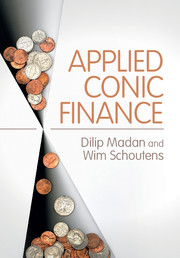Book contents
- Frontmatter
- Dedication
- Contents
- Preface
- Acknowledgements
- 1 Financial Mathematics Principles
- 2 Stochastic Processes and Financial Models
- 3 Numerical Techniques
- 4 Conic Finance
- 5 Conic Pricing
- 6 Applications of Conic Finance
- 7 Conic Portfolio Theory
- 8 Conic Hedging
- 9 Hedging Insurance Contracts
- 10 Option Positioning
- 11 Conic Trading
- References
- Index
Preface
Published online by Cambridge University Press: 27 October 2016
- Frontmatter
- Dedication
- Contents
- Preface
- Acknowledgements
- 1 Financial Mathematics Principles
- 2 Stochastic Processes and Financial Models
- 3 Numerical Techniques
- 4 Conic Finance
- 5 Conic Pricing
- 6 Applications of Conic Finance
- 7 Conic Portfolio Theory
- 8 Conic Hedging
- 9 Hedging Insurance Contracts
- 10 Option Positioning
- 11 Conic Trading
- References
- Index
Summary
All models are wrong, but some are a bit more useful than others.
In traditional financial mathematics the focus of derivative pricing is often solely on the so-called risk-neutral price (cfr. the law of one price), or the (equilibrium) price at which we supposedly can buy and sell. However, in real markets, one observes continuously two prices, namely the price at which the market is willing to buy (bid) and a price at which the market is willing to sell (ask). Hence, if one is going for an immediate transaction, one should take into account the direction of trade (buying or selling). This book presents a theory, referred to as the twoprice theory or the conic finance theory (see later for the explanation of the word “conic”), which is about determining such bid and ask prices in a consistent and fundamentally motivated manner.
The law of one price, or (just for derivative pricers) the risk-neutral price, is a useful theoretical abstraction that serves many purposes including the concept of marking to fair market values the asset and liability positions of economic participants. Actual markets, however, recognize that the real value for positions will depend on many factors, including trade directions, the size of the trade, how fast it is conducted and who the actual counterparties turn out to be. Now, between the abstraction proposed by the law of one price and the actual realization of value in transaction lies the abstraction of the two-price theory. It provides some advantages by enabling the marking of positions to be done conservatively to higher levels (ask) for liabilities and lower ones (bid) for assets under unfavourable immediate unwinds.
Critical to the foundations of the two-price theory is an underlying concept of acceptable risks in the economy. Classically, in theories based on the law of one price, one often introduces the concept of complete markets that deliver unique prices while simultaneously eliminating all risk. Acceptable risk is then no longer an issue. The basic foundations of two-price theory is the recognition that risk elimination is typically unattainable and not available. Hence, acceptable risks must be defined.
Information
- Type
- Chapter
- Information
- Applied Conic Finance , pp. xi - xivPublisher: Cambridge University PressPrint publication year: 2016
